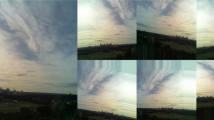Abstract
Smart advertising is an important part of the modern information industry. The main problems of smart advertising in Chinese cities at this stage include cluttered settings, single form, lack of coordination and integration between advertising and cities and urban buildings, and inconspicuous visual effects. In order to deal with these problems, it is necessary to optimize the design of smart advertisements to enhance the visual aesthetic effect. Image aesthetics quality assessment has good application prospects in industries such as image recommendation and image editing aesthetics, and can be used to help smart advertisements improve visual aesthetics. This paper proposes an objective quantitative scoring method for image aesthetics based on a multi-scale feature extraction network, which is a computational intelligence approach. The model is mainly composed of multiple multi-scale feature extraction units cascaded, and each unit contains a feature extraction layer composed of 3 different convolution kernels, fusion layer and mapping layer. The feature extraction layer forms the input end of the network by combining the global view and local view of the image. At the output end, the EMD function is used as the loss function, and the output distribution is a probability density mass function of 1–10 points. In order to verify the effectiveness of the method in this paper, the AVA dataset, which is commonly used in the field of image aesthetic evaluation, is selected for testing experiments. In this paper, two parameters, Spearman Rank Correlation Coefficient and accuracy rate, are selected as indicators to evaluate the method in this paper. The experimental results show that the method proposed in this paper is feasible and effective. Outperforms several mainstream models on the AVA dataset.



Similar content being viewed by others
References
Karayev S, Trentacoste M, Han H, Agarwala A, Darrell T, Hertzmann A, Winnemoeller H (2013) Recognizing image style. arXiv preprint arXiv:1311.3715
Wang WN, Wang L, Zhao MQ, Cai C, Shi TT, Xu XM (2016) Image aesthetic classification using parallel deep convolutional neural networks. Acta Autom Sin 42(6):904–914
Sumei L, Yongli C, Zhicheng D (2018) Objective assessment of stereoscopic image comfort based on convolutional neural network. Acta Optica Sinica 38(6):0610003
Kao Y, He R, Huang K (2016) Visual aesthetic quality assessment with multi-task deep learning. arXiv preprint arXiv:1604.04970, 5
Ke Y, Tang X, Jing F (2006) The design of high-level features for photo quality assessment. In: 2006 IEEE Computer Society Conference on Computer Vision and Pattern Recognition (CVPR’06) (Vol. 1, pp. 419–426). IEEE
Datta R, Joshi D, Li J, Wang JZ (2006) Studying aesthetics in photographic images using a computational approach. In: European conference on computer vision (pp. 288–301). Springer, Berlin, Heidelberg
Luo Y, Tang X (2008) Photo and video quality evaluation: focusing on the subject. In: European conference on computer vision (pp. 386–399). Springer, Berlin, Heidelberg
Wong LK, Low KL (2009) Saliency-enhanced image aesthetics class prediction. In: 2009 16th IEEE international conference on image processing (ICIP) (pp. 997–1000). IEEE
Marchesotti L, Perronnin F, Larlus D, Csurka G (2011) Assessing the aesthetic quality of photographs using generic image descriptors. In: 2011 international conference on computer vision (pp. 1784–1791). IEEE
Kong S, Shen X, Lin Z, Mech R, Fowlkes C (2016) Photo aesthetics ranking network with attributes and content adaptation. In: European conference on computer vision (pp. 662–679). Springer, Cham
Murray N, Marchesotti L, Perronnin F (2012) AVA: a large-scale database for aesthetic visual analysis. In: 2012 IEEE conference on computer vision and pattern recognition (pp. 2408–2415). IEEE
Talebi H, Milanfar P (2018) NIMA: neural image assessment. IEEE Trans Image Process 27(8):3998–4011
Liu D, Puri R, Kamath N, Bhattacharya S (2020) Composition-aware image aesthetics assessment. In: Proceedings of the IEEE/CVF winter conference on applications of computer vision (pp. 3569–3578)
Tu Y, Niu L, Zhao W, Cheng D, Zhang L (2020) Image cropping with composition and saliency aware aesthetic score map. In: Proceedings of the AAAI conference on artificial intelligence. Vol. 34, No. 07, pp. 12104–12111
Hou L, Yu CP, Samaras D (2016) Squared earth mover’s distance-based loss for training deep neural networks. arXiv preprint arXiv:1611.05916
Beliakov G, Yearwood J, Kelarev A (2012) Application of rank correlation, clustering and classification in information security. J Networks 7(6):935
Rodríguez-Pardo C, Bilen H (2019) Personalised aesthetics with residual adapters. In: Iberian Conference on Pattern Recognition and Image Analysis (pp. 508–520). Springer, Cham
Lu X, Lin Z, Jin H, Yang J, Wang JZ (2015) Rating image aesthetics using deep learning. IEEE Trans Multimed 17(11):2021–2034
Wang W, Zhao M, Wang L, Huang J, Cai C, Xu X (2016) A multi-scene deep learning model for image aesthetic evaluation. Sig Process Image Commun 47:511–518
Lu X, Lin Z, Jin H, Yang J, Wang JZ (2014) Rapid: rating pictorial aesthetics using deep learning. In: Proceedings of the 22nd ACM international conference on Multimedia (pp. 457–466)
Li Y, Pu Y, Xu D, Qian W, Wang L (2017) Image aesthetic quality evaluation using convolution neural network embedded fine-tune. In: CCF Chinese Conference on Computer Vision (pp. 269–283). Springer, Singapore
Author information
Authors and Affiliations
Corresponding author
Ethics declarations
Conflict of interest
The author declares that there is no conflicts of interest in this paper.
Additional information
Publisher’s Note
Springer Nature remains neutral with regard to jurisdictional claims in published maps and institutional affiliations.
Rights and permissions
Springer Nature or its licensor (e.g. a society or other partner) holds exclusive rights to this article under a publishing agreement with the author(s) or other rightsholder(s); author self-archiving of the accepted manuscript version of this article is solely governed by the terms of such publishing agreement and applicable law.
About this article
Cite this article
Guo, Y. Smart advertising design: a visual aesthetic effect improvement based on image data analysis. Evol. Intel. 16, 1699–1705 (2023). https://doi.org/10.1007/s12065-023-00831-5
Received:
Revised:
Accepted:
Published:
Issue Date:
DOI: https://doi.org/10.1007/s12065-023-00831-5




